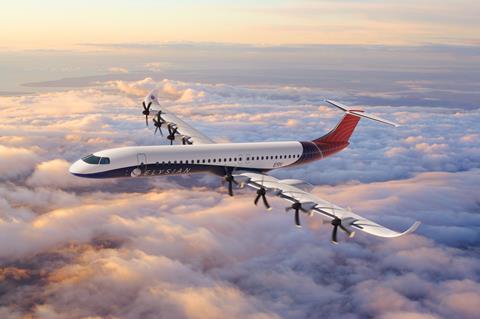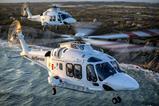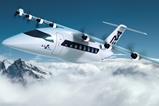Dutch start-up Elysian Aircraft claims newly published research supports its ambitious plan to develop an all-electric 90-seater for service entry in 2033, arguing that the potential for battery-powered aircraft has previously been significantly underestimated.
Established last year, Elysian says the work carried out by its team – co-chief executive and chief technology officer Rob Wolleswinkel and director of design and engineering Reynard de Vries – alongside staff from the Delft University of Technology, signals a “paradigm shift in the potential for electric flight”.

Contained in two research papers – A new perspective on battery-electric aviation, part I and II – the findings show that “large battery-electric aircraft can carry much more energy and are aerodynamically more efficient than originally assumed,” says Wolleswinkel.
Previous analysis has been based on “several misconceptions”, it argues, leading to the conclusion that battery-powered aircraft would only be suitable for short-range aircraft in the sub-19-seat commuter class.
But Elysian’s reappraisal of the data suggests a full-electric aircraft can deliver meaningful performance levels, carrying 90 passengers on routes of up to 430nm (800km), based on cells with energy density of 360Wh/kg at pack level.
“These results indicate that, to successfully reduce the climate impact of the aviation sector, battery-electric aircraft should not be designed as a niche product operating from small airfields but as commercial transport aircraft competing with fuel-based regional and narrowbody aircraft,” the second paper asserts.
In particular, any proposed aircraft must be capable of competing on an operating cost basis against the Airbus A320neo or Boeing 737 Max “while achieving a useful range which is as high as possible”, it argues.
Elysian’s resulting concept design, the E9X, envisages a low-wing aircraft with a slim fuselage – roughly the same size as the 3m (9ft 11in)-wide Embraer E-Jet – featuring four-abreast seating.
It also features a large 42m-span wing, swept at a modest 7.5°, with folding tips like those on the 777X to enable compliance with the 36m limit for Category C airport gates. In comparison, the 180-passenger A320neo has a wingspan of 35.8m.
The batteries are located in the wing-box to reduce the root-bending moment, allowing a lower wing structural weight, the study says. Or, as Wolleswinkel notes: “We put the load where the lift is”.
A “modest” aspect ratio helps to keep the span down and leaves “more volume for batteries and other powertrain components inside the wing”, as well as leading to “less critical aeroelastic and landing loads”. The main landing gear is also attached to the wing rather than the fuselage.
Thrust comes from eight 3.7m-diameter propellers powered by direct-drive electric motors. A turbogenerator located in the rear fuselage will provide a 45min reserve. Although technically this makes the E9X a hybrid-electric design, Elysian insists the turbine is there solely as a reserve, not as a range-extender.
The aircraft is also heavy for its size: maximum take-off weight is around 76t – including 35t of batteries and their packaging, or 46% of the total – broadly in line with an A320neo but with range and capacity roughly equivalent to that of a large twin-turboprop.
But Wolleswinkel argues that rather than any modern equivalent, inspiration for the E9X design comes from first-generation narrowbodies such as the 707 or Douglas DC-8. “While these jets were fuel-inefficient, they were designed for long ranges and carried a high energy mass relative to the total aircraft mass.”
While Elysian is confident in the robustness of the design so far, it has identified 10 critical issues – what Wolleswinkel calls “hot potatoes” – that need to be overcome if the E9X is to be brought into production.
These include the ability of the batteries to be recharged in 30-45min to meet airline turnaround requirements. Feedback from cell producers is that this should be achievable: “We are not talking victory yet, but I think we are pretty close,” he says.
Elysian is also considering how to package and integrate the cells into the wing in such a way that they can be swapped out in around 12h during base maintenance.
Other key issues to be resolved thermal management, the high-voltage architecture, propeller-wing integration, and the design and certification of the reserve energy system.
Work to overcome these hurdles is being carried out alongside the universities of Twente and Delft, and national aerospace research institutes in the Netherlands and Germany.
Elysian is backed by French finance firm Caravelle and Panta Holdings – a Dutch investment company that also owns MRO and completions providers Fokker Techniek and Fokker Services, plus Fokker Next Gen – a company bidding to revive the legacy aircraft brand, albeit using hydrogen propulsion.
Panta’s director of aerospace Daniel Rosen Jacobsen is also Elysian’s chief business officer and co-chief executive alongside Wolleswinkel. He estimates it will take $5-8 billion to bring the E9X into production; to date, it has raised $10 million.
Under the company’s 10-year roadmap, the preliminary design review milestone should be reached in around 2027-2028, with the design freeze coming “pretty quickly after that”, says Wolleswinkel, ultimately leading to service entry in 2033.
Elysian is still considering all options for aircraft production, including potentially partnering with established OEMs, says Jacobsen. However, in the meantime, it is looking to forge agreements with tier one aerospace suppliers for various systems such as avionics or landing gears.
“After we have got reasonable green lights from those hot potato projects this will be the logical next step to actually assess the market and work with those tier one suppliers to see who could be partners for these kinds of systems,” adds Wolleswinkel.
If it can deliver the promised performance, particularly competitive economics against existing narrowbodies, Elysian is confident there will be a substantial market for the E9X. Talks are already under way with potential airline customers, Jacobsen says.
This article has been edited to correct a cost figure in the 21st paragraph.































